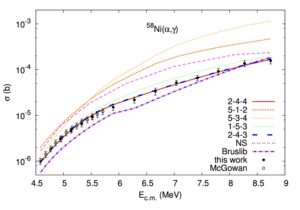 Understanding the p-process requires not only information on the stellar environment in which the process takes place, but also input from nuclear physics. The latter includes nuclear masses, half-lives of the unstable nuclei and rates of all the reactions involved. The p-process is a network of (γ,p), (γ,α) and (γ,n) reactions and their inverse on about 2,000 elements present in the environment (i.e., about 20,000 reaction). Cross sections for such a large amount of reactions have to rely on models, the most popular being HF statistical model, as the p-process involves heavy nuclei. In such case, the level densities are sufficiently high and the reactions can be described by averaged quantities. The statistical model calculations require three main components as an input: level density (LD),γ-strength function (γSF) and optical model potential (OMP).
Understanding the p-process requires not only information on the stellar environment in which the process takes place, but also input from nuclear physics. The latter includes nuclear masses, half-lives of the unstable nuclei and rates of all the reactions involved. The p-process is a network of (γ,p), (γ,α) and (γ,n) reactions and their inverse on about 2,000 elements present in the environment (i.e., about 20,000 reaction). Cross sections for such a large amount of reactions have to rely on models, the most popular being HF statistical model, as the p-process involves heavy nuclei. In such case, the level densities are sufficiently high and the reactions can be described by averaged quantities. The statistical model calculations require three main components as an input: level density (LD),γ-strength function (γSF) and optical model potential (OMP).
The most popular code for HF calculations that is publicly available is TALYS that provides the user with an option to choose between multiple versions of the input components. There are six LD models included in TALYS and five E1 γSF models for the giant dipole resonance. The OMPs available are for protons and for α-induced reactions. A detailed description of the inputs is provided in the TALYS manual.

